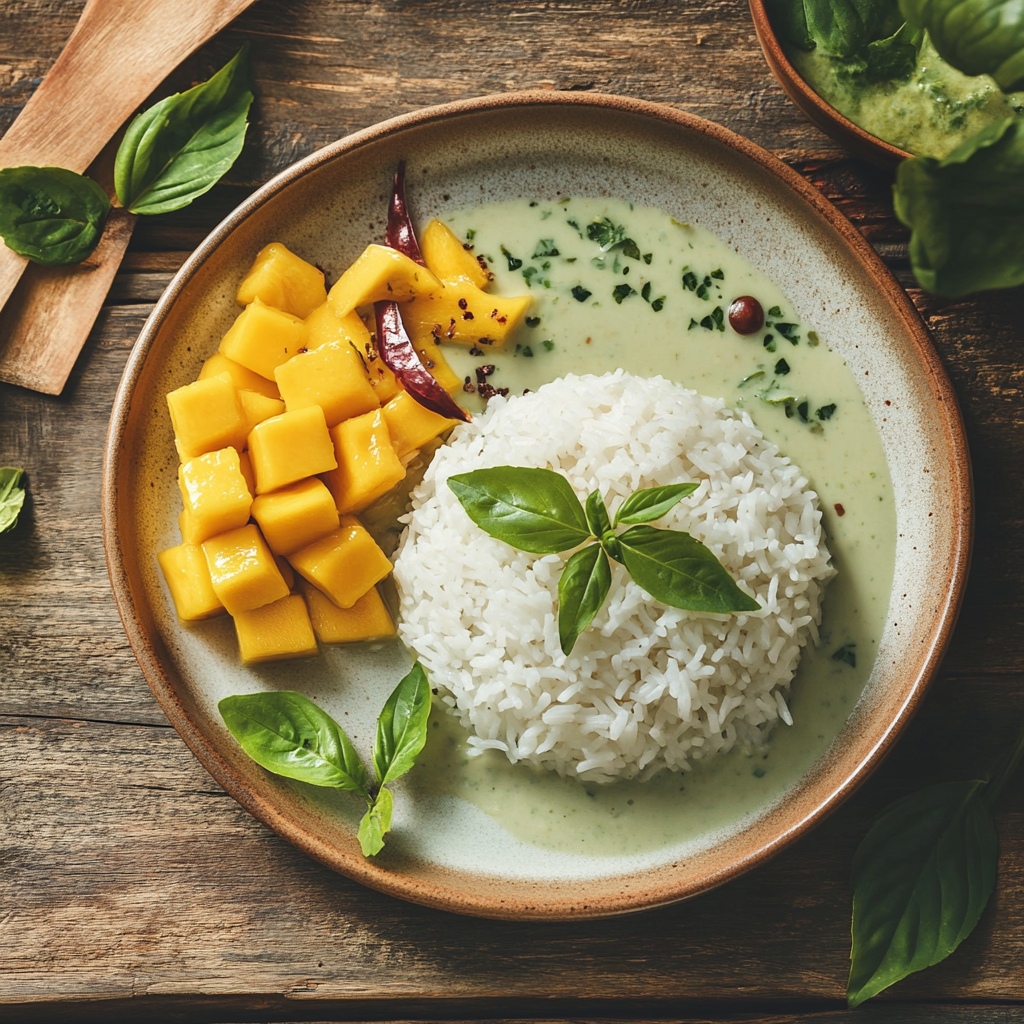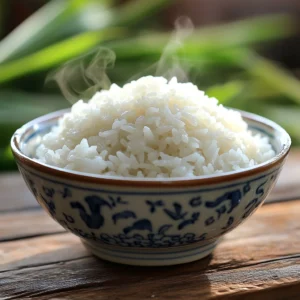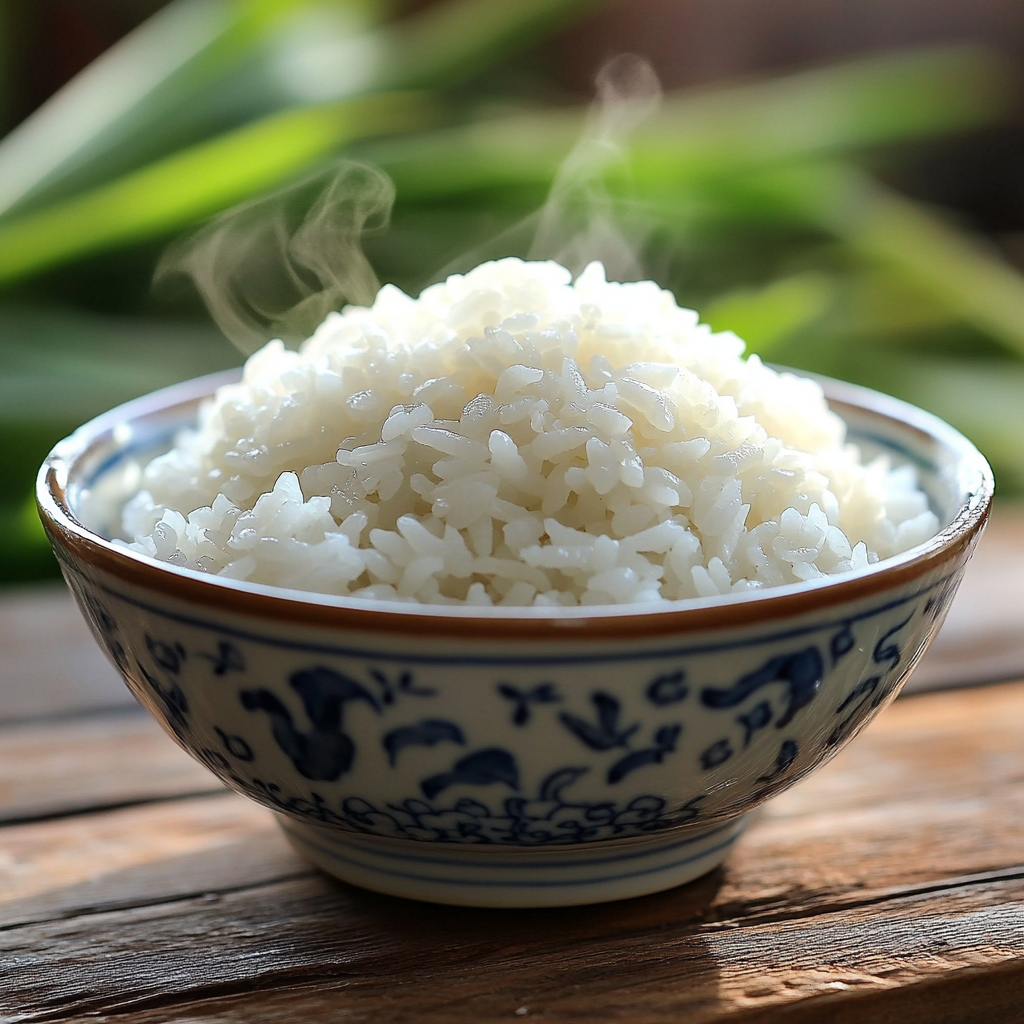Jasmine rice is a staple in many kitchens worldwide, prized for its fragrant aroma, soft texture, and slightly sweet taste. Whether you’re a home cook or a culinary enthusiast, understanding the nuances of this aromatic grain—from its origins to its nutritional value—can elevate your cooking game.
In this guide, we’ll explore everything about this popular variety, including its different types, health benefits, cooking techniques, and best storage practices. By the end, you’ll know exactly how to choose, prepare, and enjoy it.
Let’s start by diving into its history and what makes it unique!
Table of Contents
ToggleWhat is Jasmine Rice?
This long-grain rice variety is known for its delicate floral aroma and soft, slightly sticky texture when cooked. Originating from Thailand, it’s a staple in Southeast Asian cuisine, pairing exceptionally well with curries, stir-fries, and grilled meats. Unlike Basmati rice, which remains firm and separate, this variety has a naturally softer consistency that clings together slightly.
Despite its name, this fragrant grain has no actual connection to the jasmine flower—its distinctive scent comes from a natural compound called 2-acetyl-1-pyrroline, found in high concentrations in these grains.
History and Origins
With deep cultural and historical roots in Thailand, this specialty grain has been cultivated for centuries. Often referred to as Thai fragrant rice, it’s known for its rich aroma and superior quality. Today, Thailand remains the largest exporter, with premium-grade varieties grown in the Isaan and Chao Phraya River Basin regions.
The first official strain was recognized in the 1950s, and since then, it has gained global popularity. While Thailand leads in production, neighboring countries like Cambodia, Vietnam, and Laos also cultivate high-quality strains.
How It Differs from Other Rice Varieties
This long-grain staple stands apart from other types in several ways:
- Texture: Softer and slightly sticky compared to firmer, drier varieties like Basmati.
- Aroma: A distinct floral and buttery scent, unlike plain white rice.
- Grain Length: Long and slender but slightly plumper than Basmati rice.
- Cooking Behavior: Absorbs water differently and requires less soaking than some alternatives.
Though often compared to Basmati, the two are not always interchangeable in recipes. If you’re looking for a mildly floral, soft, and fluffy rice, this variety is a perfect choice!
Types and Varieties of Jasmine Rice
White Jasmine Rice vs. Brown Jasmine Rice
When shopping for the rice, you’ll often find two main varieties: white jasmine rice and brown jasmine rice. While both share the same aromatic properties, their nutritional profiles and textures differ significantly.
- White Jasmine Rice: is the most common variety. It undergoes milling and polishing to remove the bran and germ, giving it a softer texture and milder taste. However, the refining process also strips away some fiber and nutrients.
- Brown Jasmine Rice: This variety retains the bran layer, making it richer in fiber, vitamins, and minerals. It has a nuttier taste and chewier texture but takes longer to cook compared to white jasmine rice.
Organic vs. Non-Organic Jasmine Rice
Like other grains, jasmine rice is available in both organic and non-organic options.
- Organic Jasmine Rice: Grown without synthetic pesticides or fertilizers, making it a healthier choice for those concerned about chemicals in food.
- Non-Organic Jasmine Rice: More widely available and affordable but may contain trace amounts of agricultural chemicals.
Choosing organic jasmine rice ensures a more natural product, though it often comes at a higher price.
Thai Jasmine Rice vs. Cambodian Jasmine Rice
Thailand is famous for producing some of the best jasmine rice, but Cambodia also cultivates high-quality varieties.
- Thai Jasmine Rice (Hom Mali): Known for its superior fragrance and soft, fluffy texture when cooked. It’s widely considered the gold standard.
- Cambodian Jasmine Rice (Phka Rumduol): This variety has won international awards for its exceptional aroma and slightly firmer texture.
Both are excellent choices, but if you’re after the most fragrant and tender rice, Thai jasmine rice is your best bet.
Nutritional Value and Health Benefits of Jasmine Rice
Macronutrients: Calories, Carbohydrates, and Protein Content
Like most rice varieties, jasmine rice is primarily made up of carbohydrates, which provide energy for daily activities. The content of a 1-cup serving of cooked white jasmine rice is:
- Calories: ~180
- Carbohydrates: ~39g
- Protein: ~4g
- Fat: ~0.5g
Brown jasmine rice has a similar calorie count but contains more fiber, which helps with digestion and keeps you full longer.
Micronutrients: Vitamins and Minerals in Jasmine Rice
Jasmine rice contains small amounts of essential vitamins and minerals, including:
- Folate (Vitamin B9) is essential for cell growth and metabolism.
- Manganese – Supports bone health and metabolism.
- Magnesium – Helps regulate muscle and nerve function.
- Phosphorus is crucial for strong bones and energy production.
Although jasmine rice isn’t as nutrient-dense as whole grains, it still provides important micronutrients that support overall health.
Is Jasmine Rice Healthier Than Other Rice?
When comparing this aromatic grain to other types, its health benefits depend on the variety you choose.
- White Jasmine Rice vs. White Rice: Regular white rice has little to no aroma and a more neutral flavor, while jasmine rice offers more fragrance and a slightly softer texture.
- Brown Jasmine Rice vs. Brown Rice: Both are excellent sources of fiber, but brown jasmine rice has a unique floral aroma that sets it apart.
If you’re aiming for better digestion and sustained energy, brown jasmine rice is the better option due to its fiber content. But if flavor and texture are your priorities, white jasmine rice is still a nutritious choice when eaten in moderation.
How to Cook Jasmine Rice Perfectly
Stovetop Method: Step-by-Step Guide
Cooking jasmine rice on the stovetop is simple, but getting the texture just right requires attention to water ratios and cooking time. Follow these steps for fluffy, aromatic rice:
Ingredients:
- 1 cup long-grain Thai rice
- 1 ¼ cups water
- A pinch of salt (optional)
Instructions:
- Rinse the rice: Place the long-grain Thai rice in a fine-mesh strainer and rinse under cold water until the water runs clear. This removes excess starch, preventing stickiness.
- Boil water: In a medium saucepan, bring 1 ¼ cups of water to a boil.
- Add rice: Stir in the rinsed rice and salt, then reduce heat to low.
- Simmer with the lid on: Cover the pot and let it cook for 12–15 minutes, or until the water is fully absorbed.
- Let it rest: Remove from heat and let the rice sit, covered, for 5 minutes to finish steaming.
- Fluff and serve: Gently fluff the rice with a fork before serving.
This method produces soft, slightly sticky rice—perfect for serving with Thai curries or stir-fries.
Using a Rice Cooker for Jasmine Rice
If you prefer a hands-off approach, a rice cooker makes cooking jasmine rice effortless. Simply:
- Rinse one cup of jasmine rice under cold running water.
- Add 1 ¼ cups of water to the rice cooker.
- Choose the white rice setting and start the cooker.
- Once done, let the rice sit for 5 minutes before fluffing with a fork.
Tips for Fluffy and Aromatic Jasmine Rice
- Don’t skip the rinse! It helps remove excess starch that can make rice gummy.
- Use the right water ratio—too much water makes the rice mushy, too little leaves it undercooked.
- Let it rest before fluffing to allow moisture to distribute evenly.
- For extra fragrance, cook it with pandan leaves or a splash of coconut milk.
Culinary Uses and Recipes with Jasmine Rice
Popular Dishes That Use Jasmine Rice
Jasmine rice pairs beautifully with a wide range of dishes. Here are some favorites:
- Thai Green Curry – The fluffy texture of jasmine rice balances the rich, spicy curry sauce.
- Chicken Satay with Peanut Sauce – A great side for skewers of grilled meat.
- Garlic Butter Shrimp – The mild sweetness of the rice complements the garlicky, buttery shrimp.
- Mango Sticky Rice – A famous Thai dessert made with coconut-infused jasmine rice and fresh mango slices.

Best Side Dishes and Pairings
Looking for the perfect accompaniments for your jasmine rice? Try these:
- Stir-fried vegetables – A quick and healthy way to complete your meal.
- Grilled meats – Beef, chicken go wonderfully with jasmine rice.
- Spicy soups – Tom Yum or Tom Kha soup paired with jasmine rice is a match made in heaven.
Unique Recipes Featuring Jasmine Rice
Here are some creative ways to cook with jasmine rice:
1. Coconut Jasmine Rice
Cook jasmine rice with coconut milk instead of water for a rich, tropical flavor. Serve it with grilled fish or spicy curries.
2. Jasmine Rice Fried Rice
Use day-old jasmine rice to make a delicious fried rice dish with eggs, vegetables, and soy sauce.
3. Jasmine Rice Porridge (Congee)
Simmer jasmine rice with extra water or broth until it breaks down into a creamy porridge. Top with shredded chicken, scallions, and soy sauce.
For more delicious rice-based recipes, check out our recipe collection.
Storage and Shelf Life of Jasmine Rice
Proper Storage Methods to Keep Rice Fresh
Storing jasmine rice correctly is key to maintaining its aroma, texture, and quality. Here’s how to do it right:
- For uncooked jasmine rice: Keep it in an airtight container in a cool, dry place, away from moisture and sunlight. If stored properly, white jasmine rice can last for up to 2 years, while brown jasmine rice, due to its natural oils, stays fresh for about 6 months to 1 year.
- For cooked jasmine rice: Always refrigerate leftovers within two hours of cooking. Store it in an airtight container and use it within 4–6 days for the best taste and safety.
Freezing is a great option if you want to extend the shelf life. Simply portion the cooked rice into airtight bags or containers and freeze it for up to 6 months. When reheating, add a splash of water to restore its softness.
How Long Does Jasmine Rice Last?
The shelf life of jasmine rice depends on its form and storage method:
| Type of Jasmine Rice | Pantry (Airtight Container) | Refrigerator | Freezer |
|---|---|---|---|
| Uncooked White Jasmine Rice | 2+ years | Not needed | Not recommended |
| Uncooked Brown Jasmine Rice | 6 months – 1 year | Not needed | Not recommended |
| Cooked Jasmine Rice | – | 4–6 days | Up to 6 months |
Signs That Jasmine Rice Has Gone Bad
Even with proper storage, jasmine rice can go bad. Here’s how to tell:
- For uncooked rice: A rancid smell, bugs, or mold indicate spoilage.
- For cooked rice: If it smells sour, has a slimy texture, or shows mold, throw it away immediately.
Where to Buy High-Quality Jasmine Rice
Top Brands for Authentic Jasmine Rice
Not all jasmine rice is the same! If you want the best flavor and texture, go for premium brands known for their quality. Some of the top brands include:
- Three Ladies Brand – A well-loved brand for its soft, fragrant Thai jasmine rice.
- Golden Phoenix – Famous for its authentic Thai Hom Mali rice.
- Royal Umbrella – A premium option often used by professional chefs.
- Lotus Foods – Great for organic jasmine rice options.
When buying, look for packaging that says “100% Thai Hom Mali Jasmine Rice”, as this guarantees authentic, high-quality grains.
Best Places to Purchase (Online & In-Store)
You can find jasmine rice in most grocery stores, but for the best selection, check these places:
- Asian Grocery Stores – These stores often carry a wider variety of jasmine rice brands, including imported Thai rice.
- Supermarkets – Large chains like Walmart, Kroger, and Whole Foods stock popular brands.
- Online Retailers – Amazon, Walmart, and specialty food sites offer bulk buying options and organic jasmine rice varieties.
How to Identify High-Quality Jasmine Rice
When shopping for jasmine rice, keep these tips in mind:
- Check the grain color – High-quality jasmine rice should have a pearly white color (for white jasmine) or a rich tan color (for brown jasmine).
- Feel the texture – Good jasmine rice grains should be long and unbroken.
- Smell the aroma – Authentic Thai Hom Mali rice has a natural floral fragrance, even before cooking.
Environmental Impact and Sustainability of Jasmine Rice
How Jasmine Rice Cultivation Affects the Environment
Rice farming, including the production of jasmine rice, has a significant environmental impact. Some of the major concerns include:
- Water usage – Rice fields require large amounts of water, which can strain freshwater resources in some regions.
- Methane emissions – Paddy fields release methane, a greenhouse gas that contributes to climate change.
- Soil degradation – Continuous rice farming can deplete soil nutrients, making land less fertile over time.
While jasmine rice is a beloved staple, these environmental challenges highlight the need for more sustainable farming practices.
Sustainable and Ethical Sourcing Practices
Fortunately, many farmers and producers are adopting eco-friendly methods to reduce the environmental footprint of jasmine rice farming. Some of these practices include:
- Water-saving techniques – Methods like alternate wetting and drying (AWD) help conserve water while maintaining crop yields.
- Organic farming – Avoiding synthetic fertilizers and pesticides leads to healthier soil and reduces pollution.
- Fair trade certification – Some brands support ethical sourcing, ensuring fair wages for farmers while promoting sustainable agriculture.
If you want to make an eco-conscious choice, look for organic jasmine rice or brands that support sustainable farming initiatives.
Frequently Asked Questions (FAQ)
1. Is Jasmine Rice Gluten-Free?
Yes! Jasmine rice is naturally gluten-free, making it safe for people with celiac disease or gluten sensitivities. However, if you’re extremely sensitive, be sure to check for cross-contamination in processing facilities.
2. Can Diabetics Eat Jasmine Rice?
White jasmine rice has a higher glycemic index (GI) than other rice varieties, meaning it can cause blood sugar spikes. If you have diabetes, brown jasmine rice is a better option since it contains more fiber, which helps regulate blood sugar levels. Pairing rice with protein and healthy fats can also slow down digestion and prevent spikes.
3. What is the Best Substitute for Jasmine Rice?
If you don’t have jasmine rice on hand, here are some great alternatives:
- Basmati rice – Similar long-grain texture but less sticky.
- Long-grain white rice – A neutral-flavored substitute.
- Brown rice – Healthier but less fragrant.
4. How Do You Enhance the Aroma of Jasmine Rice?
To boost the natural fragrance of jasmine rice, try these tricks:
- Rinse the rice before cooking to remove excess starch and enhance the aroma.
- Cook with pandan leaves – Adding a pandan leaf to the pot gives it a floral boost.
- Use coconut milk – Cooking jasmine rice with coconut milk adds richness and depth to the flavor.
Conclusion
Jasmine rice is more than just a side dish—it’s a versatile, fragrant, and delicious grain that complements countless meals. Whether you prefer white or brown jasmine rice, knowing how to store, cook, and pair it with the right dishes can enhance your culinary experience.
We’ve explored everything from its history and nutritional benefits to cooking techniques and sustainability practices. If you’re looking for the best quality, opt for Thai Hom Mali jasmine rice, and always store it properly to maintain freshness.
Now that you’re armed with all the knowledge about jasmine rice, it’s time to put it to use! Try a new rice recipe, experiment with different pairings, and enjoy this incredible grain to its fullest.
For more cooking tips and recipes, be sure to check out our other food guides!

Guide to Jasmine Rice: Delicious Recipes
Ingredients
- 1 cup jasmine rice
- 1 ¼ cups water for stovetop or follow your rice cooker’s instructions
- ½ teaspoon salt optional
- 1 pandan leaf or ½ teaspoon coconut oil optional, for extra fragrance
Instructions
Step 1: Rinse the Rice
- Place the jasmine rice in a fine-mesh strainer and rinse under cold water until the water runs clear. This removes excess starch, preventing the rice from becoming sticky.
Step 2: Cook on the Stovetop
- In a medium saucepan, bring 1 ¼ cups of water to a boil.
- Add the rinsed jasmine rice and salt, stirring briefly.
- Cover the pot, reduce heat to low, and let it simmer for 12–15 minutes, until all the water is absorbed.
- Remove from heat and let it sit, covered, for 5 minutes to steam.
Step 3: Fluff and Serve
- Gently fluff the rice with a fork to separate the grains. Serve warm with your favorite dish!




